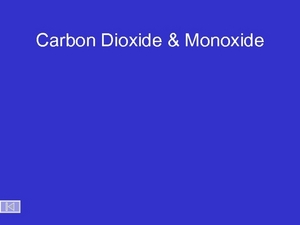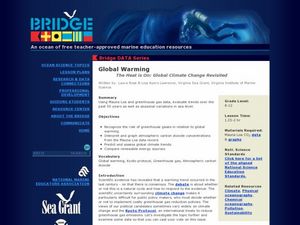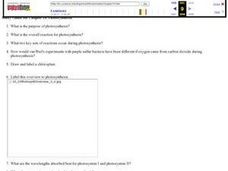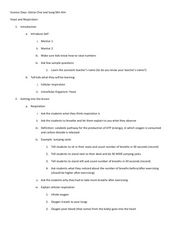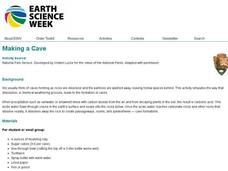Curated OER
Carbon Monoxide and Carbon Dioxide
A short slide show to illustrate the density of carbon dioxide and monoxide. An interesting look at the safety aspects to prevent CO poisoning, and the biological mechanisms by which it does harm. This elaborates on the exchange of blood...
Curated OER
Top to Bottom
Marine science classes read about the 2005 North Atlantic Stepping Stones Expedition and review climate change. They use maps to locate the seamount chains. In collaborative groups, they research how climate change may be altering the...
Curated OER
Dissolved Gases in Water
Using different types of water, earth science explorers set out to prove the ocean's ability to absorb greenhouse gases. They shake, heat, and freeze the water samples to examine gas content. This instructional activity is useful during...
Curated OER
Plant Growth and Carbon Dioxide
Young scientists show how carbon dioxide in the air affects plant growth. This math and science instructional activity provides a good platform for learners to combine scientific knowledge with mathematical representation of data. A...
Curated OER
Measuring Temperature and the Production of CO2 in Yeast
Students use a model experiment to complete an experiment on yeast. In groups, they identify the independent and dependent variables and use the scientific method to complete the activity. They record their observations and discuss them...
Curated OER
Global Warming - The Heat is On: Global Climate Change Revisited
After listening to your lecture on climate change, young scientists access NOAA's database listing Mauna Loa's carbon dioxide data. They graph the monthly means and then compare their graphs to NOAA's. This is a concise plan that could...
Curated OER
Photosynthesis Study Guide
In this photosynthesis worksheet, students answer 18 questions in a combination of multiple choice and short answers including the completion of a table.
Curated OER
Radiation and Controlling Heat Flow
The carbon dioxide in our atmosphere and its effect on how heat is contained is summarized here. The flow of heat is explained with details about insulation and conduction. There are diagrams of heat circulation on a global level and...
Curated OER
Carbon Dioxide
Students conduct a series of experiments to explore carbon dioxide properties. In this chemistry lesson, students explain the production and uses of this gas. They measure its amount in soda and waste product of yeast.
Curated OER
Trapping CO2
Learners investigate climate change and how the properties of carbon dioxide and methane play a part. In this climate lesson students use a chemical reaction to trap CO2 and methane.
Curated OER
Geologic Sequestration
Students investigate how geologic sequestration reduces carbon dioxide concentration in the atmosphere. In this earth science lesson, students simulate oil mining in the lab. They write down their observations and complete the lab report...
Curated OER
The Influence of Carbon Dioxide on the Chemistry of Soda
High schoolers investigate the carbon dioxide content of different sodas. In this chemistry instructional activity, students explain why PET containers are preferable than HDPE for soda bottles. They collect data and graph them.
Curated OER
Yeast and Respiration
Students explore oxygen properties by conducting a cell experiment in class. In this respiration lesson, students discuss the process of breathing and how oxygen is inhaled before carbon dioxide is exhaled. Students utilize yeast, water,...
Curated OER
Making a Cave
Students discuss caves. For this science lesson, students experiment with how dissolution, a chemical weathering process, leads to the formation of caves. Once the cave is finsihed students draw a picture or describe in writing what it...
Curated OER
Rice Farming
Third graders investigate how farmers get more rice from their land. In this farming lesson, 3rd graders discover things that farmers to do produce more rice. Students study photosynthesis and illustrate pictures about it. Students test...
Curated OER
Blow It Up
Students observe an experiment. In this science instructional activity, students watch an experiment where baking soda and vinegar are used to blow up a balloon. Students answer comprehension questions about the experiment.
Curated OER
Gases Lighter and Heavier than Air
Students explore the concept of air density. For this air density lesson, students fill balloons with helium and carbon dioxide. Students determine which gases are heavier or lighter than air.
Curated OER
Photosynthesis
Learners investigate photosynthesis in water plants. In this photosynthesis lesson plan, students use the elodea plant and observe gas bubbles released to determine the rate of photosynthesis. They vary the light intensity and the amount...
Curated OER
Photosynthesis: A Controlled Experiment
Students investigate the amount of starch in a plant under 3 different conditions. In this photosynthesis lesson plan, students compare the amount of starch in a plant with increased carbon dioxide conditions, a plant with decreased...
Curated OER
Pop Rock Chemistry
In this pop rock chemistry worksheet, young scholars suck on pop rocks, they mix open pop rocks with water and they observe them on a paper towel with water. Students write down as many observations as they can and they write down as...
Curated OER
Photosynthesis
For this photosynthesis worksheet, students study the illustration provided and then use the 5 words listed to fill in the blanks in the sentences at the bottom of the worksheet. Students use the 5 words to label the arrows in the...
Curated OER
Producing and Testing for Gases
In this gases worksheet, students conduct an experiment to produce 2 different gases and use standard tests to identify each gas. This worksheet has 14 short answer questions.
Curated OER
What Are Compounds?
In this compounds worksheet, students complete a Venn diagram by comparing and contrasting the characteristics of water and carbon dioxide.
Curated OER
The Carbon Cycle
In this carbon cycle worksheet, students will read about the carbon cycle and study a diagram showing what creates carbon dioxide and what uses carbon dioxide. Students will then complete 4 short answer questions.


